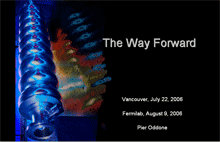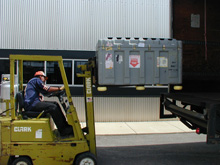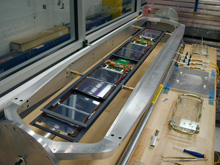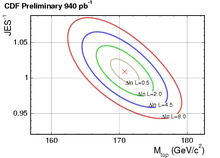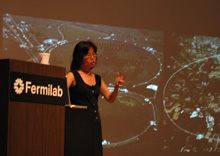 | Thursday, August 10, 2006 |
|
Thursday, August 10
2:15 p.m. Hadron Collider Physics Summer School Open Lecture - Auditorium Speaker: R. Dixon, Fermilab Title: Physics with Accelerators - 2 2:30 p.m. Theoretical Physics Seminar - Curia II Speaker: P. Hernandez, Universidad de Valencia Title: Exploring the Origin of the I = ½ Rule in Lattice QCD 3:30 p.m. DIRECTOR'S COFFEE BREAK - 2nd Flr X-Over 3:45 p.m. Hadron Collider Physics Summer School Open Lecture - Auditorium Speaker: M. Shapiro, Lawrence Berkeley National Laboratory Title: Simple and Compound Objects - 1 4:00 p.m. Accelerator Physics and Technology Seminar Curia II (NOTE LOCATION) Speaker: R. Johnson, Muons, Inc. Title: Muon Beam Cooling for Colliders, Neutrino Factories, and Experiments
Friday, August 11 Click here for a full calendar with links to additional information. |
|
Extended Forecast |
Secon Level 3 |
|
Thursday, August 10 -Southwestern Chicken Tortilla -Philly Style Cheese Steak -Garlic Herb Roasted Pork -Tomato Basil Chicken Parmesan -Assorted Slice Pizza -Marinated Grilled Chicken Caesar Salads Wilson Hall Cafe Menu |
|
Thursday, August 10 Dinner -Seafood Salad -Veal Saltimbocca -Julienne of Peppers, Onions and Basil -Hazelnut Cake w/Crème Anglais
Wednesday, August 16 |
| Fermilab Today is online at: http://www.fnal.gov/today/ Send comments and suggestions to today@fnal.gov Fermilab Today archive Hurricane Relief Page Fermilab Today PDF Version Fermilab Result of the Week archive Fermilab Safety Tip of the Week archive Linear Collider News archive Fermilab Today classifieds Subscribe/Unsubscribe to |
| ||||
|
In a talk yesterday, Pier Oddone described the direction of High Energy physics in the world, the nation and at Fermilab. He touched on the importance of reports such as "Rising Above the Gathering Storm" and "EPP2010" for US HEP, and noted that Europe and Japan have followed suit with recent reports on HEP priorities in their regions.
Oddone also described the recommendations of the P5 panel for the United States: to keep the ILC and LHC the highest priority while supporting four new projects for FY08, including the Dark Energy Survey; a more advanced Cryogenic Dark Matter Search; the Daya Bay neutrino experiment in China; and the NOvA experiment, which will study neutrinos sent from Fermilab to Minnesota. "We have a large role to play in NOvA," he said. Oddone went on to describe R&D efforts for the ILC at Fermilab, outlining the $25-million investment the lab has made in the current fiscal year. He emphasized the need for unified, international support, saying, "all regions should stay strong."
Streaming video of the talk is available online.
|
|
ABC News Online August 9, 2006: Big Bang machine gears up for atomic smash Scientists are close to finishing a machine that is aimed at recreating what they think happened at the beginning of the universe. One hundred metres under the French-Swiss border, scientists are preparing for their own version of the Big Bang.
Researchers from the the CERN Laboratory in Geneva are working on what is known as the Large Hedron Collider (LHC).
|
| Weighing a firecracker | ||
| ||
|
Imagine trying to weigh a lit firecracker with a short fuse. If the
firecracker weighed the same as a gold atom, but was much smaller in size and
it decayed faster than any other known particle, then you'd be close to
imagining the challenge of measuring the top quark mass.
To measure the top quark mass, physicists need to add up the mass and energy of all the pieces produced in its decay. One major complication in this measurement is that the quarks produced in the decay appear in the detector as broad showers of particles called "jets," which only approximate the original quark energy and direction. The lack of certainty in the jet energies contributes the most to the uncertainty in the top quark mass measurement. To decrease the overall uncertainty, all of the available detector measurements from each top quark decay are combined into a precise equation. The complicated equation relates the quantities measured from the CDF detector to all of the possible arrangements of top quark production and decay in order to determine the most probable value of the top quark mass. Using this approach, CDF has analyzed one inverse femtobarn of data taken from 2002 to 2006 to measure the top quark mass to be 170.9 +- 2.5 GeV, achieving a precision of 1.5 percent. This single measurement is the most precise top quark mass measurement to date. Combining the best CDF and DZero measurements in all the top decay channels, the average value for the top mass is 171.4 +- 2.1 GeV. The new CDF measurement contributes about 60 percent to this world average. The value of the top quark mass is important because it helps constrain the mass of a particle predicted by the Standard Model but not yet observed, the Higgs boson. Current top mass measurements are encouraging to physicists looking for the Higgs: the results suggest that first signs of the Higgs are within reach of the four to eight inverse femtobarns of data scheduled to be collected at the Tevatron. Physicists eagerly await new top quark mass measurements from the Tevatron, which are now expected to reach nearly 1-GeV final precision. | ||
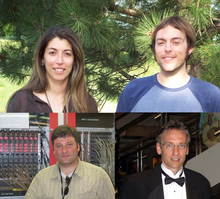 |
||
| Clockwise : Florencia Canelli (Fermilab), Brian Mohr, Jay Hauser, Rainer Wallny (UCLA). | ||
| Result of the Week Archive
|
|
August 7 - 9 - Three stores provided 32 hours and 30 minutes of luminosity. - Water leaks and bad pump motors.
Read the Current Accelerator Update |
| ||||
| The nine-day Hadron Collider Physics Summer School started yesterday. The first public lecture, titled "Physics with Accelerators," was given by AD Head Roger Dixon at 2:30 p.m. Fermilab Deputy Director Young-Kee Kim followed with a lecture titled "Passing the baton: Tevatron-LHC team." A full HCPS schedule is available online, and you can find a distilled list of this week's public lectures here. If you can't make it to the lectures, watch them online. |
|
Note to travelers Due to last night's arrests in conjunction with a plot to detonate explosives on transatlantic flights, airport security has been heightened. If you plan to travel by air today, please allow extra time for airport security. More Information |
